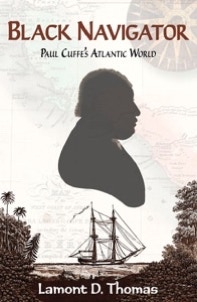
“I Shall be ready and willing through the permission of God to Serve my brethren in any way which may attend to their advancement.
… and let us Endeavor to Establish the Corrector of Colour that it may shine brighter and brighter.”
–Paul Cuffe



This 32-point, dry card gimbaled compass, made by Isaac Greenwood of Providence in 1780, was owned by Paul Cuffe around 1800. Courtesy of the New Bedford Whaling Museum.
Paperback • 200 pages • 7.25” x 10” • 30+ illustrations
Black Navigator, a 200th anniversary edition commemorating the life of Cuffe (1759-1817), is a revised edition of Rise to Be a People that draws upon the extensive research of the original plus insightful recent findings. In a creative non-fiction style, Thomas sheds new light on Cuffe’s life and times for 21st century readers.
Born to an African Ashanti father who was enslaved, kidnapped from his homeland and later freed in New England and to a local Native American Wampanoag mother whose culture and people were displaced by European colonialists, Cuffe was raised amidst Quaker traditions and later became a member of the Society of Friends. He grew up within a competing confluence of cultures —Anglo Saxon English, Native American, and the burgeoning African diaspora.
Becoming one of the most prosperous men of his time, and perhaps the most prominent free black American of his era, Cuffe rose to extraordinary wealth, fame and respect. Against enormous odds, he navigated the racially divisive world at home and abroad to become an international merchant, shipbuilder, shipmaster, entrepreneur, abolitionist and philanthropist.
Born on the tiny island of Cuttyhunk off the coast of southeastern Massachusetts, Cuffe’s influence during his lifetime grew to encompass global commercial ventures and transatlantic activism for Africans on three continents in the Atlantic World: Africa, America and Europe.
A champion of his African brethren on the many sides of the Atlantic World, he advocated they return to “rise to be a people” in Africa. He challenged the evils of slavery throughout his life. The Cuffe story explores slaveholders’ twisted rhetoric upon this movement and the complicated issues Africans and African Americans faced in declaring a homeland. Some unequivocally claimed America as home. Others chose Africa, leading to the founding of the West African nation of Liberia. Torn between the two, Cuffe finally died among family and friends in Westport, Massachusetts.
“Many of us spend our lives looking for a final home, some in our dying breath begging to go ‘home,’” writes Thomas. The Cuffe story reflects this universal journey.
Lamont D. Thomas is a retired professor and leading authority on Cuffe. He earned his bachelor’s and master’s degrees in history from Trinity College in Connecticut, where he lives with his wife Marge. Lamont’s original book, Rise to Be a People: A Biography of Paul Cuffe, (Illinois University Press, 1986), was followed by a retitled paperback, Paul Cuffe, Black Entrepreneur and Pan-Africanist. It was nominated for six awards by the University of Illinois Press, including a Pulitzer Prize in History.
Lamont teaches Tai Chi Easy and Qigong in southwestern Connecticut and goes by Lao Shan (Old Mountain) and Qi Pop to his granddaughter Kimaya Moore Thomas. Lamont and his wife Marge have two children—Byron Lamont and Angela Sophia.
A view from Lookout Hill shows early settlements on Cuttyhunk Island, circa 1880. The rocky island was owned and inhabited by the Slocum family (1693-1858), who kept African slaves in colonial Massachusetts. Among those slaves was Kofi Slocum, Paul’s father, who was freed in 1742.
